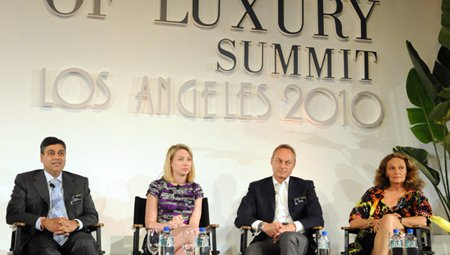Imran Amed offers a rundown of the essential highlights from the FT Luxury Summit

Imran Amed offers a rundown of the essential highlights from the FT Luxury Summit
LOS ANGELES – Luxury Society members—including Mimma Viglezio, Oliver Walsh, Susan Tabak, Erik Torstensson, Greg Shove, James Bilefield, Benjamin Aubanton and Emma Findlay—were out in full force at this year’s FT Business of Luxury Summit, joining more than 300 hundred other luxury professionals from around the world at the iconic Beverly Hills Hotel to discuss “The Medium and The Message.”
In case you missed our live Twitter coverage from the event, here’s a rundown of some of the highlights from the two day conference:
1. An Action Plan from Harrods’ New Investors?
Could Harrods’ new Qatari investors be planning a global rollout and investment in the comapany’s digital presence? There’s nothing for certain, but Fashion and Beauty Director Marigay McKee hinted that the new investors may triple the existing annual capital investment and acknowledged that the huge potential the web offers has yet to be fully exploited by the legendary London department store. Could a more elaborate online presence be in the offing?
2. Celebrities want part of the action, over the long-term
Celebrity and brand collaborations may be on the rise, but Charles Finch, Chairman and CEO of Finch & Partners said that savvy celebrities are now thinking of themselves as brands and are far more sophisticated than luxury brands often assume. Bryan Lourd of CAA concurred: "People that are famous want real partnerships with companies… “ including meaningful roles and equity shares; he added that “These are the most successful relationships by far.”
3. Don’t make your websites Flash-y
Marissa Mayer, VP of Search Products and User Experience at Google advised luxury brands against using flash in their websites. Her advice? Make your site user friendly as this also makes it Google friendly. This will also ensure that your website works on all those iPhone and iPad devices out there.
4. Keep it real on Twitter
Diane von Furstenberg reported that she loves Twitter. In fact she sends out a few tweets about empowering women, a core value of her brand, on a daily basis. She believes that once the brand message is firmly in place the sales will follow: “it’s more important to empower women than sell them a dress. If everything is marketing driven, it’s no longer real.”
5. Authenticity, Community and Doing Business
Luxury brands should keep in mind three important principles as they craft their digital strategies, according to Joe Raspars, Founding Partner of Blue State Digital and strategic architect for Barack Obama’s digital campaign: Authenticity, Community and Doing Business. Raspars explained the campaign attracted 13 million people active online supporters,, translating into 20% of the votes cast for Obama overall and 2/3 of the finance for his campaign.
5. Prada’s Online Store in North America to launch on 1 July
Sebastian Sulle, COO of Prada Group, revealed that the Italian luxury fashion house, which has become known for its guarded and independent approach to digital media, will launch its online store in the United States and Canada on July 1st, 2010, complementing the online offering already available in Continental Europe.
6. Luxury media as dreamweavers
Jonathan Newhouse, Chairman of Conde Nast International, struck an optimistic tone for the prospects of the media conglomerate’s prestigious magazine brands. “The role of the media is to be the dreamweaver,” he said, pointing to the rise of titles like Paris Vogue, and the success of the GQ app, which sold 20,000 copies without any promotion at all, proving, Newhouse says, that users will pay for an electronic product.
7. Rayban is tweeted every 7 minutes
Even though neither Ray-Ban nor Luxottica officially tweet, every six or seven minutes there’s a tweet about the timeless sunglasses brand— an important argument for joining and being part of the online conversation, according to Fabio d’Angelantonio, EVP & Chief Marketing Officer of Luxottica.
8. Chinese shoppers are dominating European luxury goods sales
Chairman Emeritus of the Estee Lauder Group, Leonard Lauder, revealed that 60% of VAT refund forms in France are filled out by Chinese shoppers; while Marigay McKee explained that the Chinese are ranked fourth amongst international tourists shopping at Harrods. McKee expects this number to grow even higher once UK visa regulations for Chinese tourists coming from the continent are relaxed in the next 12-18 months.
Luxury Society was the official business network of FT Business of Luxury Summit 2010.










